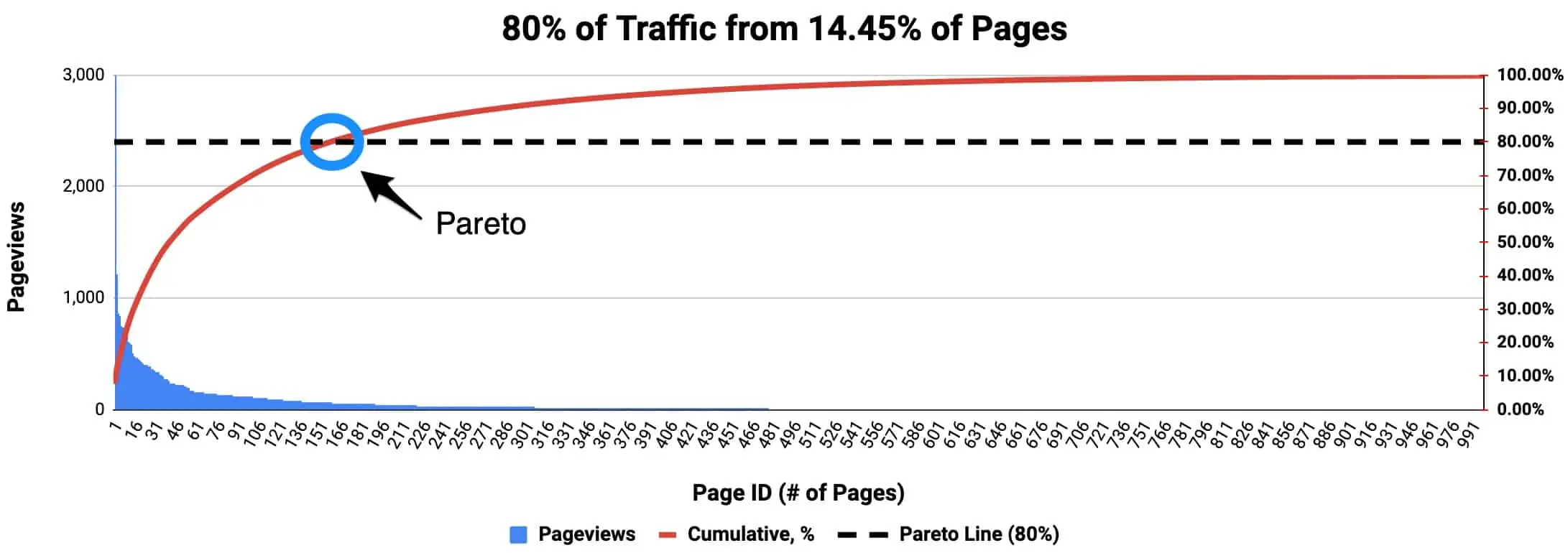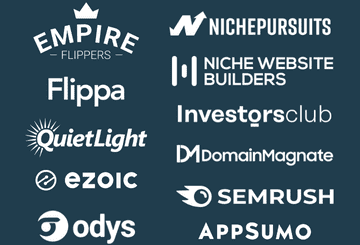One thing I learned very quickly was that there’s always more work to be done for niche sites. The “to-do” list generally only gets larger, not smaller. This is a major reason why having a good system in place is so important.
Using the Pareto Principle, also known as the 80/20 Rule, as the foundation of any system is going to increase the chances of success. In this write-up, I cover 8 examples in the niche website investing space where I’ve seen this principle show up over and over again.
Let’s get into it!
What is the 80/20 Rule?
The 80/20 rule from 19th-century Italian mathematician Vilfredo Pareto states that 80% of results come from 20% of actions. These are rough estimates as sometimes it’s 75/25 or 85/15 but 80/20 seems to be a good common average.
Long popular among many economists, the Pareto Principle hit the mainstream powerfully with the publication of Tim Ferriss’s The 4 Hour Work Week.
You can go more in-depth on the 80/20 with the following links, but if you keep in mind 20% of actions equals 80% of results you have the gist of it:
- Pareto Principle on Wikipedia
- Tim Ferriss interview goes in-depth on 80/20
- Good YouTube video walkthrough on 80/20
Does the 80/20 Rule Apply to Niche Websites?
The 80/20 rule applies to niche websites in a surprising number of ways. It’s a ratio that comes up in important ways throughout the process.
From finding good deals to creating content and making on-site changes, consistently it’s a small handful of actions that have a disproportionately large impact on the total results.
If you talk to long-time affiliates with multiple sites, almost all of them will have one or a handful of sites that stand clearly above the rest.
This means that if you understand the 80/20 rule and how to apply it, you can create systems that get the most impact from each and every action.
Let’s get into a few examples of this principle in action.
5 Examples of 80/20 Rule When Growing Niche Sites
My experience with niche sites over nearly 13 years has shown 80/20 to be true again and again. Sometimes in some surprising ways.
1. Quality Content: 80% of Traffic/Revenues from 20% of Articles
Some articles will be winners, some will be losers, most will fall in between. However, consistently the top 20% of articles will bring in 80+% of all the traffic the website receives. That also means those same articles will make 80% or more of all the profit.
This has been true across dozens of different website niches, monetization methods, and site styles. The top 20% of winners will bring in the overwhelming majority of traffic and income.
👉 Case Study: 80% of Traffic from 14.45% of Pages
I analyzed my outdoor site to see if the organic traffic to pages follows closely the Pareto principle. To do this, I created a Pareto Chart using pageview data from Google Analytics.
Check out the results below:
View Google Sheets raw data and analysis:
Check out the analysis below:
This is what each axis means:
- X-axis: unique ID for each page (or also can be seen as the number of pages on the site) getting organic search traffic
- Left Y-axis: pageview totals over the last 30 days for each unique page
- Right Y-axis: total cumulative percentage of pageviews
Here are my findings:
- The site has 1,079 articles
- Last 30 days, the site received 46,724 pageviews. Pareto is at 80% or 37,379 pageviews.
- 156 highest traffic pages generated 37,379 pageviews reaching Pareto
- 156 pages equate to 14.45% (156/1,079) of the total number of articles on my site
My takeaways:
Note that the Pareto principle means 80% of results come from 20% of actions. It’s a rough natural phenomenon, not a statistic to follow. Pareto DOES NOT mean that I could have just published 156 articles to get the 37,379 pageviews. That’s not how organic traffic works nor niche website investing.
What it does mean is that, naturally, each article will not perform to your expectation regardless of your domain’s authority (mine is DR 41), quality of content, SEO tactics, among other factors. Content for niche websites is a combination of quality content balanced with the quantity of content.
This case study exercise just showcases that even niche websites follow the Pareto principle. My site did not hit the perfect 80/20 rule but it is close enough. You will see the 80/20 take effect in most online businesses and it’s something I try to follow.
2. CRO Is Key: 80% of Additional Revenue from 20% of On-Page Changes
Conversion rate optimization makes a huge difference when it comes to increasing profits. While there might be many different steps to take to optimize a page on a site I’ve bought, inevitably just 20% of those changes will provide 80% of the revenue increase.
All the changes matter to fully optimize a page, but depending on the niche changes like product comparison tables, quality call-out buttons, or ad type/placement changes that will show the biggest growth.
3. Quality Backlinks: 80% of Domain Authority from 20% of Backlinks
Backlinks are not just a numbers game. Not all links are created equal. A small handful of really good authoritative backlinks from major sites will produce huge jumps in rankings. Far more than hundreds of small links from no-name pages or blogs Google is barely aware of.
The big backlinks are going to be the ones that really move the needle when it comes to Google seeing my site as a trusted authority site.
4. Better Hires: 20% of Your Team Will Produce 80% of Results
Great employees are game-changers. No matter how good I am at hiring a capable team, no matter how many really great candidates end up getting interviewed, there’s still going to be a top 20%.
Those members of the team will get work done and their work will produce 80% of the results. Even among the elite, some are just more effective. Look at any professional sports league for a clearcut example of how that works.
5. Easy Wins First: 80% of Easy Wins Will Come from 20% of Tactics
Even from my own collection of tactics, EasyWins.io, which I apply to every single site I buy, build, or sell, I know there are certain easy wins that will have a huge effect while others will have much smaller effects.
Some tactics create major improvement regardless of niche or site. Others are important but it takes many of them together to keep moving the needle.
The number of “very high” win impact actions on WasyWins.io even falls in the Pareto Principle range with 25% of all the actions listed as very high impact.
3 Examples of 80/20 Rule When Flipping Niche Sites
Flipping niche sites takes a lot of work. It’s important that my actions and time must be optimized to deliver the best results. One of the most powerful parts of the 80/20 Principle is that not only does it tell me what to focus on, but it tells me what to ignore, as well.
1. Focus Your Time: 80% of Your Time Spent in 20% of Your Sites
When balancing multiple sites the workload can become overwhelming if I let it. Most people who have bought and sold websites have felt this feeling at some point. Since there’s only so much time, it only makes sense to spend most of my time on the sites that show the most growth and promise.
The evidence is in the revenue numbers. The sites that are paying off are the ones that deserve more of my attention. The ones that show mild to moderate growth only get what time is left. This lets me know that I’ll get maximum results (and profits) from my work.
2. Ignore Sources: 80% of Quality Deals Come from 20% of Sources
Why spend 10 hours going over all possible deal sources when you know most of the good deals come from 1-2 spots you can review in a fraction of the time? The answer is that you shouldn’t.
While there are definitely times I’ll go on the hunt for a new deal, after years of doing this I know what the best sources are for the types of niche sites I want to find. My time is best spent at those platforms because those will give me the majority of my potential good deals.
Only when those sources are at a dry spell is it worth moving on to the other 20% of sources.
3. Important Levers: 20% of Website’s Factors Account for 80% of Sale Valuation
The Pareto Principle applies when it comes to figuring out the valuation when buying or selling a niche site. Despite the many things that go into creating a good niche site three things stick out above the rest:
- Profit,
- Domain age, and
- Backlink profile.
Earnings are the first thing every buyer wants to know about. This is going to be the main factor in determining value.
I am also willing to pay extra for a site that has a very old and established domain or a truly impressive backlink profile that has quality links that would be very hard, expensive, or impossible to duplicate.
These three factors matter more to website buyers than everything else combined, and it’s not particularly close.
Apply Pareto Principles To Your Websites!
A good system is invaluable. By understanding Pareto’s 80/20 Principle, I can set up systems that make sure my time is being used most effectively. This goes for whether I’m searching for a new deal, improving the value of my current batch of websites, or preparing for a new sale.
By keeping the 80/20 Principle in mind I’ve been able to build strong effective systems that move the needle and don’t waste time. I’d strongly recommend this for anyone needing to create systems for business or for life to try this out.




